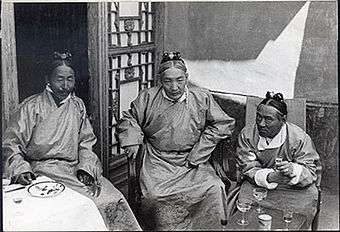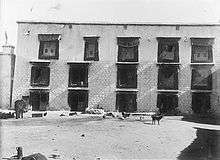Trimön

Trimön Shap-pe born Norbu Wangyal (c.1874 - 1945) was a noted Tibetan conservative politician and governor and a financial secretary of Tibet (Tsipön; Tibetan: rtsis-dpon). He was one of the eminent officials involved in the search and recognition of Tenzin Gyatso, the 14th Dalai Lama in 1935.
Biography
He was the second son of the late Tsi-pa Sherab, a 6th rank official. He married into the Trimön family and took the family name on inheriting the estates of his wife's father at Chetang, near Lhasa although he lived for many years at Sechung House.[1]
Career
In 1912, Trimön, despite no formal military training, was assigned to a post as Assistant Commanders-in-Chief of the Tibetan army during the Chinese conflict at Lhasa. In June of that year he was given the title of Theiji.[1]In 1913-1914, he accompanied Lönchen Shatra to India as his Assistant to the Tibetan Plenipotentiaries at the Simla Convention and conversed with Lord Hardinge. When he returned to Tibet in 1914 he was appointed the title of Shap-pe.[1]
Throughout the 1920s Trimön worked as the Commissioner in Eastern Tibet. His position ended in 1931 when Nga-pho Shap-pe was brought in to resume his role. Despite being a competent figure, with substantial literary knowledge, he was unpopular with the National Assembly and was widely reported to be very conservative, stern and arrogant.[2] He was one of the victims of Lungshar's plot which failed in the summer of 1934.[1]
After the 13th Dalai Lama's death in 1933, in the summer of 1935, Trimön was amongst the eminent officials who set out with the kashag to find the reincarnated 14th Dalai Lama.[2] The search sent them across Tibet as well as visiting the customary Lhamo La-tso several times, a lake where it was said to offer clues as to the whereabouts of the reborn Dalai Lama.[2]
Resignation

During this time he grew increasingly affected by the government in Tibet and following the search for the new Dalai Lama ordered his nephew, Shakabpa while staying at Tiklo Monastery to write a letter tending his resignation from his position to the high council saying that "he had advanced in age and would like to resign and devote the remaining part of his life to his religious pursuits."[2] The regent, the Fifth Reting Rinpoche attempted to get Trimön to change his mind and believed he should be promoted to lönchen as he had desired and stated he would also resign from the cabinet if Trimön quit.[2] Trimön returned to Lhasa in October 1935 and despite Reting's words he resigned officially shortly before the Tibetan New Year in January 1936.[2] Reting did not resign as he had promised and did not reply straight away, but after the Losar celebrations, Reting replied to Trimön, formally thanking him for his service to Tibet and granted him the estate Kaship Nubling.[2]
At this time, concerns increasingly grew in regards to Trimön's mental state and his behaviour became increasingly eccentric.[2] He was perceived to display occasional fits of insanity.[1] He was seen at the market in Lhasa wearing a white Shamthab (a lower dress worn by ascetic lamas) and playing music and dancing and was reported to have banged heavily on the doors of Jokhang temple yelling for the monks to open it.[2] He responded strangely to Reting's offer of Kaship Nubling and tried to garner support to be reninstated and there is much evidence to suggest that Trimön did not genuinely want to resign from the government but had become distressed with his position and the situation.[2] Trimön resigned on the grounds that he would still be consulted to offer advice on important affairs.[1] He remained suspicious of the Chinese until his death in 1945 as Reting's government grew increasingly weak after his departure.[1][2]
References
- 1 2 3 4 5 6 7 "Trimon Shappe". The Tibet Album:British photography in Central Tibet (1920 -1950), University of Oxford. Retrieved September 21, 2009.
- 1 2 3 4 5 6 7 8 9 10 11 Goldstein, Melvyn C. (1991). A History of Modern Tibet, 1913-1951: The Demise of the Lamaist State. Philip E. Lilienthal Asian studies imprint, University of California Press. pp. 310–314. ISBN 9780520075900.